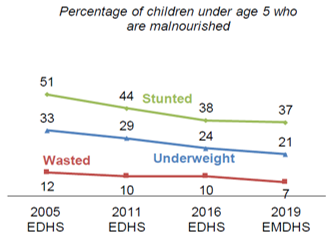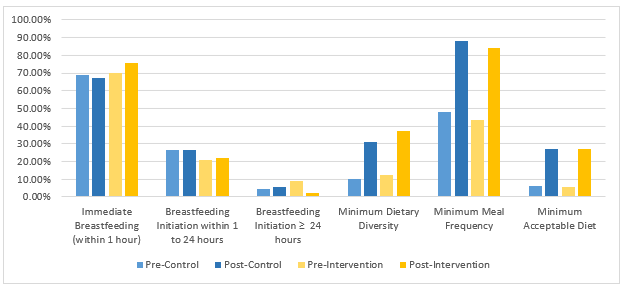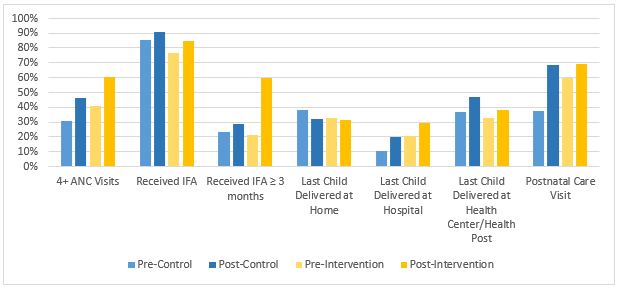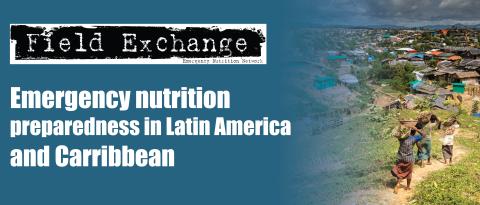Improving nutritional outcomes of rural households through a community-based approach in Ethiopia
This article has been updated since the original version was published in March 2020.
By Haimanot Abebe, Lioul Berhanu, Wossen Assefa Negash and Daniel Abbott
Haimanot Abebe is a Communication and Reporting Specialist working for Growth through Nutrition Activity in Save the Children Ethiopia. She previously worked for the Development Food Assistance Programme for Save the Children and as a Research Assistant for Nia Center for Children and Family Development.
Lioul Berhanu is Programs Deputy Chief of Party for the Growth through Nutrition Activity project in Save the Children, overseeing quality implementation of the project’s multi-sector nutrition activities. He previously worked as Nutrition Advisor for the same project and Senior Health and Nutrition Specialist at Save the Children Ethiopia.
Wossen Assefa Negash is a Senior Social Behaviour Change Communication (SBCC) Manager for Growth through Nutrition Activity in Save the Children Ethiopia. He is a qualified public health professional with a background in SBCC, communication research, strategy formulation, campaigning, training and material development.
Daniel Abbott is Chief of Party of the Growth through Nutrition Activity project in Save the Children Ethiopia. He has 15 years of experience in nutrition; health; and water, sanitation and hygiene programming and has led large, multi-sector nutrition programmes in Ethiopia.
Save the Children’s Growth through Nutrition Activity project is funded by the United States Agency for International Development (USAID) under the Feed the Future Initiative. Two of Growth through Nutrition’s international partners, The Manoff Group and Tufts University, contributed greatly to this article through their research papers. Five local non-governmental organisations also played a large role in implementing the Enhanced Community Conversations in the project’s four implementation regions.
Location: Ethiopia
What we know: In spite of reductions in undernutrition, the prevalence of stunting in children under five years old in Ethiopia remains high.
What this article adds: Growth through Nutrition is a five-year (2016-2021), multi-sector nutrition and water, sanitation and hygiene (WASH) programme implemented in 110 districts in four regions of Ethiopia that aims to prevent stunting in the first 1,000 days of life. Alongside WASH and livelihoods interventions, social behaviour change communication (SBCC) is targeted to very poor households with family members within the first 1,000 days’ window. The SBCC component, Enhanced Community Conversations, involves 10 discussion sessions in peer groups (15-20 members) facilitated by trained volunteers on set topics related to healthy nutrition and WASH practices, with follow-up home visits. Some groups also receive virtual facilitation in the form of audio recordings on the same set topics. Qualitative and quantitative assessments revealed improvements between baseline and midline in provision of a minimum acceptable diet to infants age 6 to 23 months, iron and folic acid supplementation in pregnant women, number of antenatal and postnatal care contacts, and household WASH practices. Results on the impact of breastfeeding behaviours were mixed (qualitative results suggested improvement, but this was not reflected in quantitative results). The addition of virtual audio facilitation showed some statistically significant improved outcomes, but this should be balanced against costs. Results demonstrate the importance of SBCC within a package of nutrition-sensitive interventions, targeting men with SBCC messaging as drivers of change in households, and the potential for institutionalising this approach in routine government systems. The impact on maternal and child nutrition outcomes (including stunting) will be measured at endline.
Background
Ethiopia has made significant progress in reducing child malnutrition over the last 15 years. However, although undernutrition is declining, stunting remains a significant problem (Figure 1). In 2019, nearly two out of every five children (37%) in Ethiopia under the age of five years old were stunted and more than one in 10 (12%) were severely stunted. Stunting is also nearly twice as prevalent in rural areas (46%) as urban areas (26%) (EMDHS, 2019). The impacts of malnutrition are enormous for individuals, communities and the country as a whole, from the immediate consequences of acute malnutrition, or wasting, to the long-term adverse effects of chronic malnutrition, manifested through delayed physical, mental and psychosocial development.
Figure 1: Trends in nutritional status of children in Ethiopia (EMDHS, 2019)

A wide range of factors, including maternal, infant and young child nutrition; water, sanitation and hygiene (WASH); and household gender dynamics contribute to the nutritional wellbeing of mothers and children in the first 1,000 days of life - a critical window of opportunity for a child’s growth and development. Only 7% of children between the ages of 6 and 23 months meet the criteria for a minimum acceptable diet (MAD) in Ethiopia1 (EDHS, 2016) and recent figures estimate that 59% of infants up to the age of six months are exclusively breastfed, while the remaining 41% either additionally consume water, various liquids, milk from other sources, complementary foods, or are not breastfed at all (EMDHS, 2019). Other important causal factors are maternal undernutrition (in the past five years, 60% of women who gave birth in Ethiopia took iron-folic acid (IFA) tablets during pregnancy and only 11% took them for the recommended 90+ days (EMDHS, 2019)) and lack of optimal WASH facilities (nearly two in five (43%) of rural households do not have access to an improved drinking water source in Ethiopia and a staggering 94% of households use an unimproved toilet facility (EMDHS, 2019)). An important underlying cause of undernutrition in Ethiopia is the lack of female autonomy and decision-making at household level, which has been found to be negatively associated with household dietary diversity (Masters et al, 2017) and child anthropometric outcomes (Abate and Belachew, 2017). Lack of maternal education is another important factor: 42% of children born to mothers with no education were found to be stunted in recent estimates compared with 17% of children whose mothers have more than secondary education (EMDHS, 2019).
Programme description
The Feed the Future Ethiopia Growth through Nutrition Activity is a United States Agency for International Development (USAID)-funded multi-sector nutrition and WASH project implemented in 110 districts of four major regions in Ethiopia (Amhara; Oromia; Southern Nations, Nationalities and People’s Region (SNNPR); and Tigray). The primary objective of this five-year (2016-2021) project is to prevent undernutrition during the first 1,000 days. The project delivers nutrition-sensitive and nutrition-specific livelihoods and agriculture activities; social and behaviour change communication (SBCC) on nutrition, WASH, and agriculture-related behaviours; improved nutrition service delivery; access to WASH products and services; and multi-sector coordination and capacity building to implement the National Nutrition Programme2 and One WASH National Programme.3 In addition, the project implements cross-cutting activities to support gender and women’s empowerment, programme learning (for example, through baseline and endline surveys and evaluations), convergence and overlay of multi-sector activities, and emergency preparedness planning.
The SBCC approach
The SBCC component of the programme involves multiple sectors and utilises a ‘whole-household nutrition’ approach. Its goals are to improve the dietary practices of pregnant and lactating women, infants and young children, and adolescent girls between the ages of 10 and 19; increase demand for nutrition and health services; improve WASH practices; and address imbalances in household gender relations. The strategy involves the identification of nutritionally vulnerable household members (those within the first 1,000 days’ window with a three-month food gap) who are targeted with interventions to support changes in practices in line with project aims. Interventions also aim to foster a stronger enabling environment for beneficiary households by targeting schools (teachers and adolescent girls and boys), communities, religious leaders, farmers’ associations, women’s savings and credit groups, and frontline workers in the agriculture and health sector. A package of multi-media SBCC materials is used in a variety of platforms, including Enhanced Community Conversations (ECC), SMS text messaging and radio.
Enhanced Community Conversations
The First 1,000 Days ECCs were originally designed under the USAID-funded Empowering New Generations to Improve Nutrition and Economic Opportunities (ENGINE) project, the predecessor of Growth through Nutrition. ECCs are peer support groups comprised of 15-20 mothers, fathers and grandmothers of children under two years of age who meet in their respective groups on a regular basis (generally once a month) for a total of 10 sessions. Each session covers specific topics, information and skills related to nutrition-specific and nutrition-sensitive behaviours during the first 1,000 days. These sessions are followed by home visits to support households to implement agreed messages.
ECCs are facilitated by a community change agents (CCAs), who are community volunteers trained on the nutrition information covered in the ECCs and equipped with a package of multi-media SBCC materials to facilitate discussion and learning through peer-group activities. Activities may include listening to and discussing nutrition-related information and experiences, singing nutrition songs, demonstrations, skills-building games and role plays. Creative concepts are used to help mothers, fathers and grandmothers build on the knowledge, experiences and skills that they already have and practice adopting new behaviours and transformative gender roles through an experiential learning approach. Some ECC groups are augmented with virtual facilitation (VF). These groups all received the same face-to-face support, but in addition received pre-recorded VF audio sessions of two professional actors, who role-play around issues raised in the SBCC materials.
Growth through Nutrition implements ECCs in partnership with The Manoff Group through five local non-governmental organisations and village savings groups organised under the project’s agriculture and livelihoods component. In its first three years of implementation, Growth through Nutrition supported close to 30,500 ECC participants in four regions and aims to graduate an additional 10,600 community members by September 2021. Around 50% of households targeted with the project’s agriculture and livelihoods intervention (provision of small livestock, vegetable seeds and fruit seedlings) also receive the ECC intervention. Agriculture frontline workers facilitate the development of homestead gardens and provide advice on animal rearing and, in doing, so support positive nutrition messaging.
Assessment of programme impact – methodology
This article draws on the results of three studies to assess changes in maternal and infant and young child feeding (IYCF) practices as a result of the programme:
The ‘Documentation research on the USAID Growth through Nutrition First 1,000 Days maternal and child nutrition program outcomes and lessons learned’, hereafter referred to as the ECC documentation study, outlines outcomes and lessons learned from the implementation of the First 1,000 Days programme. This qualitative research study, led by the Manoff Group, was conducted in Amhara, Oromia, Tigray and SNNP regions using 32 focus group discussions (FGDs) and 32 in-depth, semi-structured interviews with key informants. A total of 234 mothers, fathers and grandmothers who participated in ECCs, male and female CCAs, health and agriculture frontline workers, religious leaders and municipality leaders participated in the study. Research participants were purposively sampled in two kebeles (neighbourhoods) in each of the four regions.
The ‘Effectiveness of virtual facilitator as an SBCC approach for improving nutrition status of women and children’ study, hereafter referred to as the Virtual Facilitator (VF) comparison study, was designed to evaluate the added value of the ECC VF tool (pre-recorded audio content with fictional characters used to augment ECC sessions led by facilitators) for improving IYCF practices and the nutritional status of women and children in project implementation areas. Since this approach incurs additional expense, it was important to find out if it led to additional benefits and therefore had potential for scale. A quantitative household survey was conducted using a quasi-experimental study design in purposively selected districts of Amhara and Oromia regions. A total of 410 pregnant and lactating mothers participated in the survey; women were sampled from an intervention group (who attended ECC sessions with VF) and a control group (who attended ECC sessions without VF). The study lasted approximately one year, from December 2018 to November 2019. Tufts University led the design of the study, recruitment and training of data collectors, and field supervision of data collection.
A Growth through Nutrition midterm evaluation was also undertaken to assess the successes and challenges of project implementation from project baseline to mid-point. The study considered seven evaluation questions, one of which focused on whether ECCs are associated with key behavioural outcomes. This evaluation followed a mixed-methods design which included a desk review of project documentation (including project baseline (2017) and follow-up (2018) household surveys and the VF comparison study), semi-structured key informant interviews with project staff, and programme-review meetings held in 10 purposively selected districts across the four regions. Woreda (district) selection primarily targeted high- and low-performing woredas per region, as rated by project staff considering all multi-sector components of the project. The programme-review meetings involved government representatives from the health, agriculture, and WASH sectors from regional, zonal, district and municipality levels and were facilitated by project staff trained on data capturing tools and supervised by an external consultant.
Results
Improved maternal, infant, and young child nutrition practices
Participants in the ECC documentation study indicated that IYCF practices changed positively as a result of the First 1,000 Days ECCs. Participants reported that mothers were giving colostrum to their newborns and exclusively breastfeeding their babies during the first six months. Review meetings from the midterm evaluation also supported these findings, although VF comparison study quantitative data for early initiation of breastfeeding showed minimal or no changes (Figure 2). Results of the VF comparison study showed a modest increase in the age of exclusively breastfed infants in both control (4.95 to 5.14 months) and intervention groups (4.64 to 5.16 months).
Participants of the ECCD documentation study reported improvements in minimum dietary diversity (MDD) and minimum meal frequency (MMF) among target intervention groups. They reported that families were introducing thick porridge when children reached six months old and were growing, buying and preparing nutritious complementary foods to ensure that their children had a diverse and nutritious diet. Qualitative study participants routinely mentioned carrots, beetroot, meat, eggs, butter, oil, bananas, oranges, avocado, papaya and other foods as good options to include in the preparation of soft, thick porridges for children, beginning at the age of six months, demonstrating good knowledge on MDD. Figure 2 shows data from the VF comparison study that indicate a dramatic increase in MAD of children aged 6 to 23 months (6.12% to 26.9% in ECC only groups and 5.6% to 26.9% in ECC+VF groups). The difference in change between groups was statistically significant (p=0.017), demonstrating that VF had added benefit for MAD compared to in-person SBCC facilitation alone. Improvements were also seen in MDD scores (10.2% to 31.3% for ECC-only groups and 12.2% to 37.5% in ECC+VF groups) and MMF, although this change did not achieve statistical significance.
Figure 2: Key IYCF behaviours: Breastfeeding and complementary feeding indicators

ECC documentation study participants frequently identified IFA supplementation as a behaviour change among pregnant women that was catalysed through their participation in the ECCs and supported by CCAs during home visits. The VF comparison study supported these findings, particularly among the intervention group (Figure 3), which showed a 21% to 60% increase in IFA intake for three months or greater, with modest improvements in the control group of 23% to 29% (p= 0.004). The VF comparison study also indicated an increase in women attending four or more antenatal care (ANC) visits in both control (30.7% to 46.4%) and intervention (41% to 60.5%) groups, with a significantly bigger difference seen in the ECC+VF group (p=0.04). There was also a notable increase in postnatal care received within two days after birth in both control (37.5% to 68.2%) and intervention (59.4% to 69.5%) groups, with bigger difference noted in the control group, p=0.004, demonstrating the contribution of the ECC intervention, in general, in improving health seeking behavior for specific health services among both groups. Only a modest increase was seen, however, in institutional deliveries (hospital or health post/health centre) in both groups pre and post interventions.
Figure 3: Maternal and newborn health and nutrition services utilisation

Improved WASH practices
Across all regions, target households in the ECC documentation study reported improved WASH practices, including handwashing with soap and water, building and using latrines, keeping compounds swept, separating farm animals from the household, and washing clothes more frequently. The VF comparison study demonstrated a decrease in no handwashing from 29% in the control group and 24% in the intervention group to 0% for both groups. Participants reported discussing nutrition and diversified diets with their husband or partner, although conversations were often initiated by women. Participants of both the ECC documentation study and midterm evaluation reported that fathers and mothers were intentionally keeping more nutritious foods for family consumption, rather than selling everything they produce.
Lessons learned
Results show that Growth through Nutrition’s First 1,000 Days ECC approach has had a positive impact on the improvement of nutrition-specific and nutrition-sensitive behaviours among target households. These positive outcomes are attributed to several key strengths of the programme, in spite of a few shortcomings.
Diffusion of learned behaviours
The First 1,000 Days programme has gone beyond individual behaviour change to achieve social change in three broad areas: (1) the diffusion of nutrition-related practices among neighbours of target households; (2) improved interpersonal relationships among family members and neighbours, and (3) transformation in gender roles and power dynamics in households and communities.
Across all four regions, many FGD participants reported that their neighbours and other relatives often ask them about what they learn in the ECCs, observe the new practices they are employing in their homes, and imitate them. New practices ranged from handwashing with soap and water and building latrines to growing vegetables in backyard gardens and improving child feeding practices. Improved WASH practices appear to have diffused particularly rapidly in communities. Findings from the FGDs in the ECC documentation study suggest that the work of frontline health workers, combined with the information and skills promoted during the ECCs and home visits by the CCAs, are the reasons for this successful outcome. For example, ECC graduates in some districts were assigned to cascade their learning to up to five pregnant and lactating neighbours.
Reinforcing knowledge, attitude and skills through SBCC materials
Results revealed that behaviour change and social change can happen rapidly when materials, messaging and interventions are appropriately designed. The package of complementary materials and interventions, including VFs, take-home posters, skills-building games and role plays, were all frequently referenced by research participants. These SBCC materials were methodically designed to encompass a behaviour-centred focus that began with formative research on behaviours and behavioural influences, and included the careful testing of creative concepts, messages and materials as part of the design phase. Take-home posters, in particular, appear to be very influential in catalysing discussion about nutrition practices at home and among neighbours, and appear to validate the credibility of the information that ECC participants relay. Both VF and non-VF-facilitated ECC sessions have contributed to changes in key IYCF indicators. ECC+VF sessions had significantly higher positive outcomes for MAD, postnatal care-seeking behaviours, attendance at four or more ANC visits, duration of IFA supplementation and hand-washing practices. This suggests that supplementary audio materials are essential tools that effectively communicate and reinforce messages to target audiences.
Targeting fathers and husbands for improved nutritional outcomes
Results of the ECC documentation study show that fathers and husbands are very receptive to maternal and child nutrition information, appreciate being directly targeted with materials and interventions designed specifically for them, and appear to be the greatest influencers of change in their families. Husbands in the FGDs expressed that they were keen to teach their wives what they had learned and wives were receptive to their messages, while mothers and grandmothers were often met with scepticism when trying to relay ECC messages to their families. These findings suggest that, although all the ECC participants appear to have changed their nutrition-related practices and to have influenced others, it is easier for men, rather than women, to initiate these changes at home and in the neighbourhood.
Programme challenges
Challenges for ECC implementation were largely related to technical issues and time requirements, such as ECCs taking too long (1.5 hours) from the perspective of participants and group coordinators, and poor mobile phone sound quality during VF transmission. A few challenges encountered during home visits included difficulty in following up with participants after graduation, CCAs not using counselling materials as intended, the feasibility of reaching the targeted number of monthly visits, and difficulties reaching fathers during home visits.
The Growth through Nutrition project plans to mitigate some of these challenges by developing a handover guideline for government staff to ensure the sustainability of the intervention, reinforcing time management through CCAs, cutting back the number of visits CCAs are expected to conduct, and exploring options for better reach of fathers during household visits.
Next steps
Despite qualitative assessments reporting positive changes in both breastfeeding and complementary feeding-related practices, quantitative assessment has shown only a modest effect of ECCs on related indicators. This calls for further research to understand inconsistencies in the results and a review of the content of the sessions and/or content delivery.
Going forward, consideration will be given to the institutionalisation of ECC within existing government structures to ensure cost-effectiveness, scalability and sustainability. Participants in the programme-review meeting of the midterm evaluation recommended that ECC facilitation training be extended either to all municipality-level extension workers, or to development armies. Furthermore, although the VF comparison study showed that both VF and non-VF approaches are effective in bringing about changes in key IYCF indicators, the most cost-effective approach could be prioritised during institutionalisation.
Conclusion
Assessments of the Growth for Nutrition project to date have demonstrated as a whole that structured and interactive community-based SBCC sessions, when implemented within a package of multi-sector support (including messaging on WASH and livelihood interventions), have the potential to bring about positive changes in key maternal and IYCF practices. Key to the success of the ECC approach in this context was the targeting of men in households and the addressing of underlying gender imbalances in household decision-making. This element of the programme should be factored into future SBCC approaches in similar contexts.
Supplementation of the ECC approach with audio materials further enhanced some positive nutrition and health-related practices; however, the cost benefit of this approach must be considered in each context, particularly in terms of sustainability and scale. The project shows the potential for embedding similar programmes in government systems, given that ECC implementers in this context were trained government health extension workers. Changes in outcome indicators, including stunting in children under five years old and maternal nutrition status, will be measured among all project participants in the endline survey, the results of which will be shared.
For more information, please contact Lioul Berhanu at lioul.berhanu@savethechildren.org
References
Abate KH, Belachew T. (2017). Women’s autonomy and men’s involvement in child care and feeding as predictors of infant and young child anthropometric indices in coffee farming households of Jimma Zone, South West of Ethiopia. Department of Population and family health
Ethiopian Public Health Institute (EPHI) [Ethiopia] and ICF. 2019. Ethiopia Mini Demographic and Health Survey (EMDS) 2019.
Ethiopian Public Health Institute (EPHI) [Ethiopia] and ICF. 2016. Ethiopia Demographic and Health Survey (EMDS) 2016.
The Manoff Group (2019). Documentation Research on the USAID Growth through Nutrition First 1000 Days Maternal and Child Nutrition Program Outcomes and Lessons Learned.
Masters, W.A., Spielman, K., Heneveld, K.M., Theys, N.C., Coates, J. (2017). Level and variation of diet quality in rural Ethiopia: Does consumption smoothing maintain household dietary diversity during lean seasons? Tufts University. Retrieved from https://dl.tufts.edu/concern/pdfs/gf06gf46x
International Development (2015). Improving nutrition outcomes with better water, sanitation, and hygiene: practical solutions for policies and programs. Retrieved from https://apps.who.int/iris/bitstream/handle/10665/193991/9789241565103_eng.pdf?sequence=1
1 A composite of minimum dietary diversity (MDD) and minimum meal frequency (MMF) for infants.
2 The National Nutrition Program of Ethiopia (2016-2020) is a government-led nutrition programme developed to reduce the magnitude of malnutrition through the implementation and scale-up of multi-sector, coordinated and harmonised evidence-based nutrition interventions.
3 The OWNP (2013-2020) is a national programme that coordinates the efforts of the water, education, health and finance sectors to increase equitable and sustainable access to water supply and sanitation and the adoption of good hygiene practices to improve the health and wellbeing of communities.


